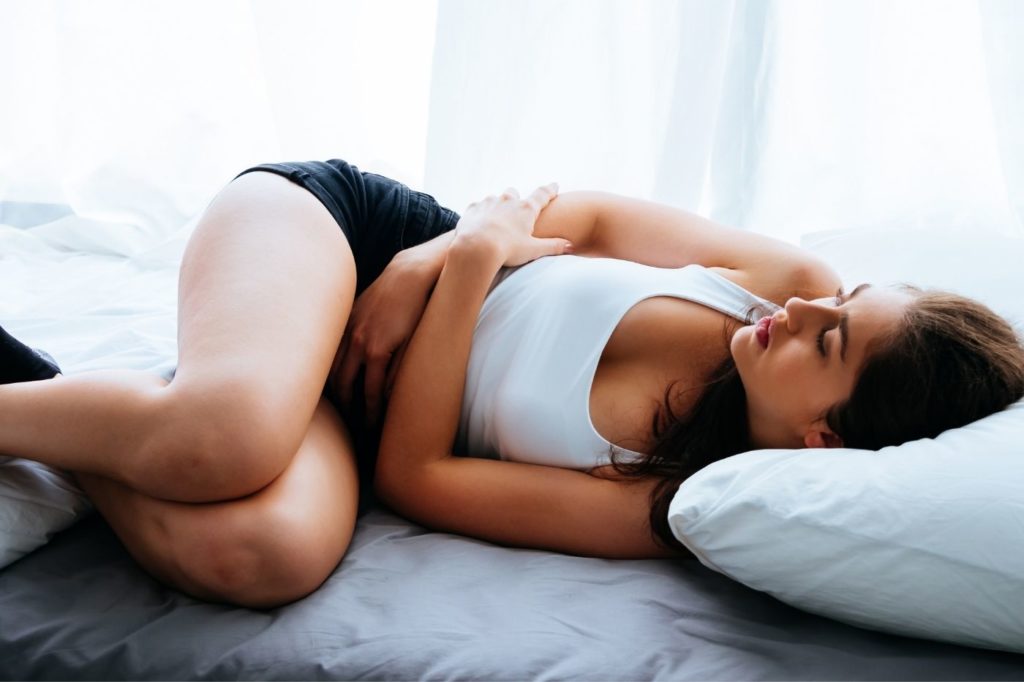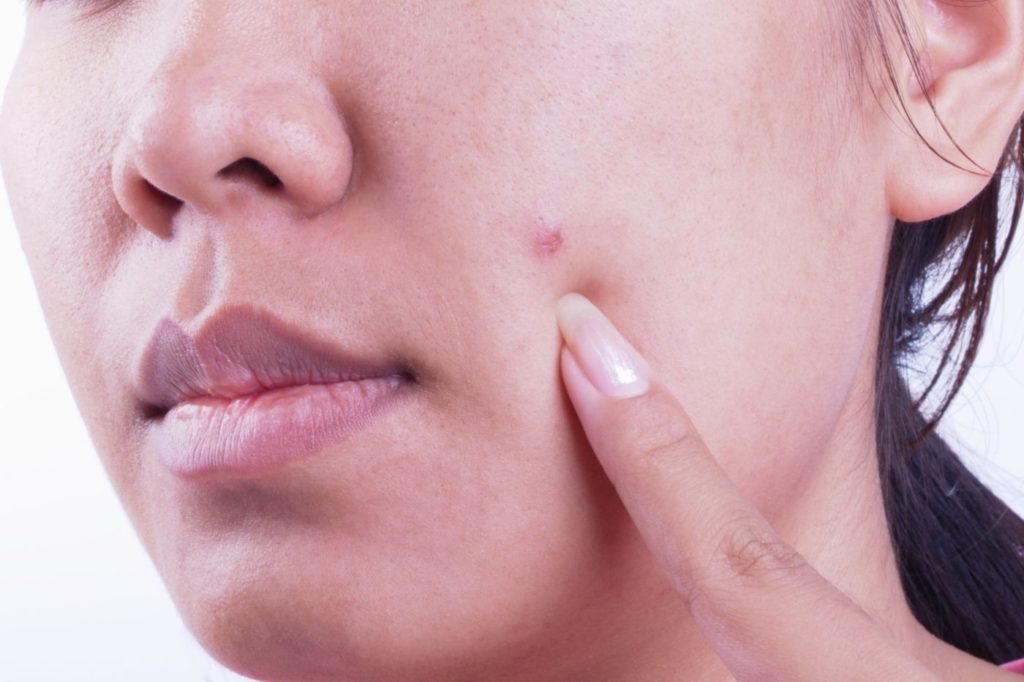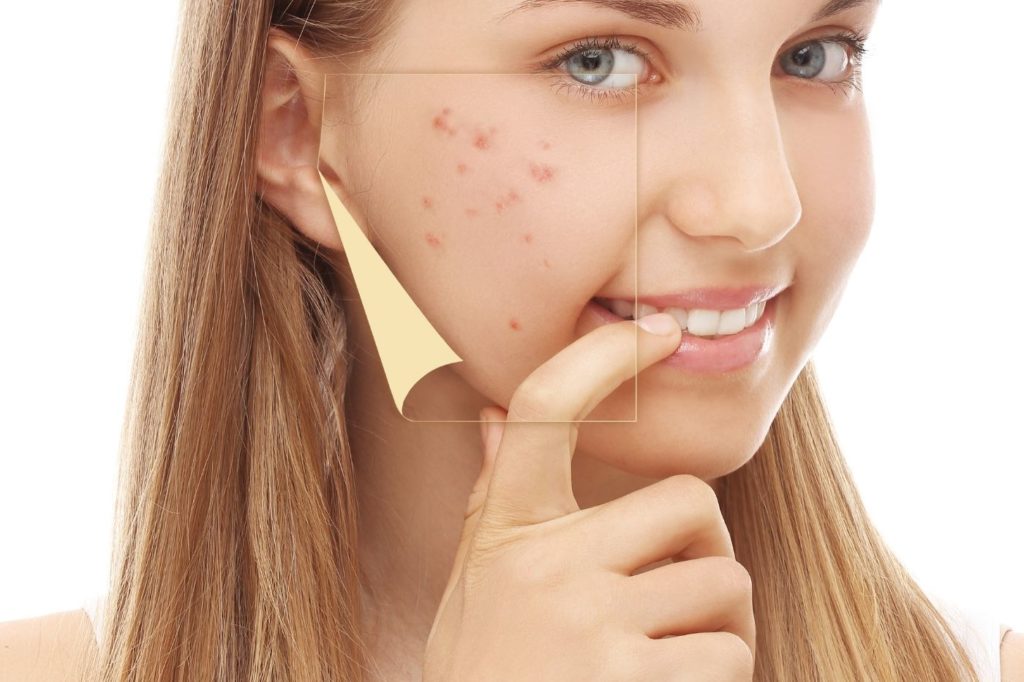
Acne before your period is a common part of PMS. It can also coincide with your natural skin cycle. Let’s take a look at why it happens — and what to do about it.
Your skin looks great for days, then you near your period, and BOOM… Acne rears its ugly head again.
If you’re like most women, this probably sounds all too familiar.
Why? Between bloating, cramps and moodiness, aren’t we already dealing with enough?
Turns out, premenstrual acne flare-ups are a common issue. Roughly half of all women face acne before periods every month. This is because the same hormones that cause other PMS symptoms play essential roles in our skin’s health.
Does your skin change before your period? For most of us, yes. As our hormones fluctuate and become imbalanced, many women are plagued with unusually red and inflamed pimples and (rarely) develop whiteheads. These blemishes will typically be on the lower half of the face and jawline.
Skin Cycle & Hormones 101
What happens to skin before your period? Before our periods, the hormones estrogen and progesterone drop, and testosterone takes over. This signals our oil glands to produce excess oil and can cause clogged pores and acne breakouts.
Let’s take a closer look at the hormones responsible for our pre-period papules and what they do individually.
Estrogen
Estrogen is the most well-known female hormone and regulates our reproductive systems and secondary sex characteristics.
Estrogen also stimulates:
- Collagen production (which keeps skin plump)
- Elastin production (which keeps skin springy)
- Hyaluronic acid (which helps skin retain moisture and occasionally gives it that dewy, glowy appearance)
Progesterone
Progesterone is another key female reproductive hormone involved in menstruation and pregnancy. It has many jobs, but the one we’ll discuss right now is how it affects our skin.
Progesterone activates oils glands, or sebaceous glands, which stimulate the production of sebum, a thick oily substance that keeps skin lubricated.
Testosterone
Testosterone is an androgen, meaning it is a hormone that regulates male characteristics. While it is commonly referenced as the manliest hormone, testosterone plays a vital role in skin quality for both sexes: it regulates skin thickness and sebum production, which helps keep our skin from drying out.
In addition to these hormones, we also produce chemical compounds called prostaglandins. These create a wide range of hormone-like effects, usually including controlling inflammation. When hormones are off-balance, however, prostaglandins can cause increased sensitivity to pain.
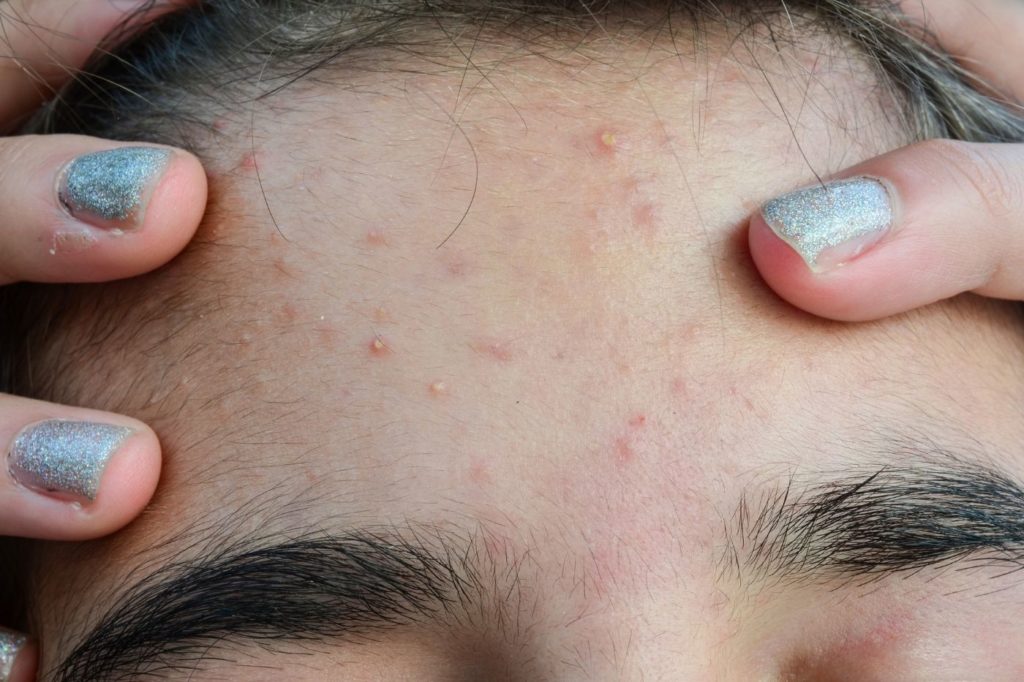
Timeline of Your Skin During Your Cycle
Now that we have a basic understanding of what our sex hormones do for our skin, let’s take a look at the timeline of a typical menstrual cycle. We’ll notice how these hormones fluctuate and what that means for our skin.
Before we dive in, remember that your skin cycle and menstrual cycle both approximate to a monthly cycle.
Our skin cycle is the rate at which the top layer of skin renews itself. This generating new skin cells and shedding old ones can take anywhere from 4-6 weeks. A menstrual cycle, on the other hand, typically lasts 4-5 weeks.
Days 1-6
On the first day of your period and throughout the following 5 days, all hormone levels are low. Sebum production will slow down. Your skin’s moisture retention will drop and, because estrogen is low, the skin may appear dry and dull.
This is also when the prostaglandins will cause the most trouble. (For anyone asking, this would not be the ideal time for waxing, given the potential for dry and extra sensitive skin.) By day 3, both estrogen and testosterone will slowly begin to rise again.
Days 7-11
This is the beginning of the follicular phase. Estrogen levels should be rising. This means collagen, elastin, and sweet, dewy hyaluronic acid will be back on track.
Because new skin cells are getting all those estrogen benefits, this is an excellent time to use chemically exfoliating skincare products and encourage skin turn-over. Out with the old dead skin cells, in with the new!
Days 12-16
Ever noticed that your skin seems to “glow” a little more before your period?
Here’s why your pre-period skin may have an extra glow: Just before ovulation, estrogen will be at its peak, meaning extra collagen and elastin make pores look smaller. Testosterone levels climb along with estrogen, adding moisture. This is when we appear to have that healthy glow.
Days 17-24
After ovulation, we reach the luteal phase (roughly the second half of your total cycle). Progesterone levels rise as estrogen drops. This means sebaceous glands will produce more sebum, causing the skin to swell slightly and pores to appear smaller.
Before celebrating those tiny pores, it is important to remember that compressed pores mean trapped bacteria. This can become a breeding ground for inflammatory acne or, in severe cases, cystic acne.
How many days before my period do I get acne? Acne before periods starts about 3-7 days before you menstruate.
Days 25-28
We’re still in the luteal phase, but PMS is in full swing, and so are your oil glands (this is when oily skin is most apparent). Testosterone has taken over and, because oil production has already been booming, hormonal acne will reach its height.
Skin may appear shiny and puffy thanks to excess oil and swelling. This is also when cystic acne is most likely to flare.
Hint: don’t try to pop that large painful bump on your chin. If it’s a cyst, it’s a losing battle.
Is acne a sign that my period is coming? Acne may be a sign that your period is on its way, but this differs by person. Based on the active hormones during PMS, acne is likely a sign that menstruation is around the corner.
If you have concerns or an unusual amount of acne for your cycle, consult a board-certified dermatologist.
How to Treat Hormonal Acne
While the timeline seems hopeless, fear not, ladies! There are plenty of treatment options to combat premenstrual acne. Now that we’ve got a handle on why the acne occurs, let’s find out what we can do to even out the skin changes during that time of the month.
Diet
Maintaining a healthy diet may lessen the breakouts caused by hormone shifts. You’ll want to avoid foods that cause inflammation and consider adding some foods to your diet that help fight excess androgens.
Foods to avoid:
- Sugar
- Dairy
- Refined carbs
- Alcohol
- Gluten
- Fried foods
- Caffeine
- Non-organic eggs
Foods to consider increasing:
- Nuts and seeds
- Chickpeas
- Edamame
- Fish
- Shellfish
- Organic chicken
- Leafy greens
- Plant oils (avocado, olive, sunflower, etc.)
Skin Care
For a more straightforward approach, take a look at some topical options.
- Adapalene and benzoyl peroxide are the top-recommended OTC treatment for acne
- Tea tree oil is both anti-inflammatory and anti-microbial, which could make for clearer skin
- Salicylic acid is a non-abrasive exfoliant and could help clear up and prevent future acne by keeping pores free of dead skin cells
- Glycolic acid, or AHA, is a slightly stronger acid exfoliant
- Bentonite clay masks are both effective and satisfying
- These DIY masks are great if you want to get your hands dirty (but your face gorgeous)
Supplements 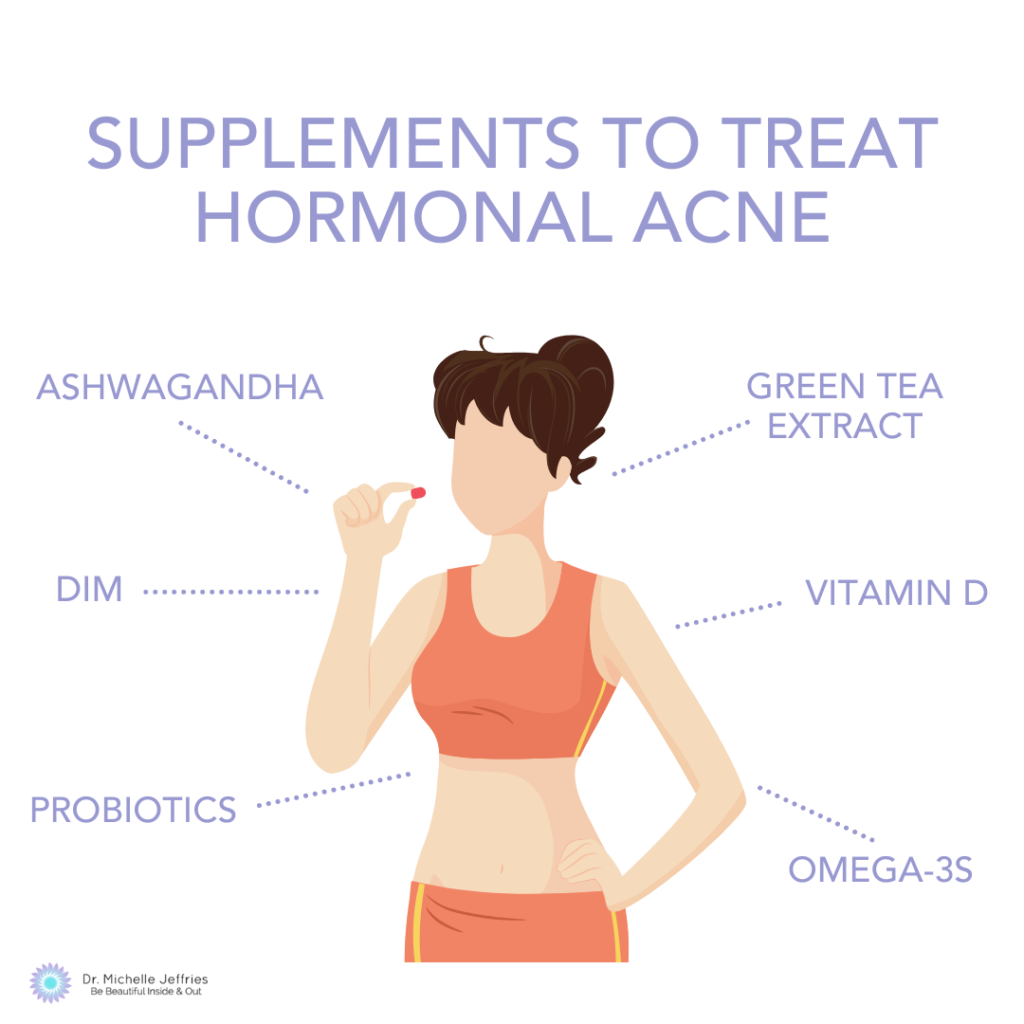
There are also supplements you can take to help balance hormones and reduce inflammation. Here are a few of my favorites:
- Ashwagandha, an herbal antimicrobial and anti-inflammatory adaptogen supplement with many calming and whole body benefits (it may reduce acne-causing cortisol levels)
- Probiotics can reduce inflammation and help prevent acne
- DIM (diindolylmethane) is a nutrient derived from cruciferous veggies that can help balance estrogen levels
- Green Tea extract is another natural anti-inflammatory
- Omega-3s are fatty acids that can help reduce inflammatory acne
- Vitamin D has been shown to help fight acne
Medication
If over-the-counter topical remedies and dietary changes just aren’t working, you might consider trying medication. Ask your dermatologist about the following:
- Dapsone, various strengths: This helps calm inflammation and tends not to dry out your skin. It’s one of the top go-to topical treatment options prescribed by dermatologists due to its low risk of side effects and it’s not an antibiotic.
- BPO/Clindamycin combinations, various strengths of each: This power couple kills bacteria, like C. acnes, that can cause flare-ups and can help rebalance the skin microbiome.
- Adapalene/BPO combinations, various strengths of each: Adapalene is a retinoid that slows the growth of cells, reduces inflammation, and fights pimples. You already know how effective benzoyl peroxide is.
- Erythromycin, alone or combined BPO (called Aktikpak): Erythromycin is a prescription antibiotic that fights acne-causing bacteria, however resistance can develop when it’s used by itself. BPO can complement it to peel back a fresh layer of skin.
- Tretinoin, various strengths and combinations: Tretinoin is prescription strength retinoid that helps with blackheads and whiteheads and may also help with some of those fine lines and discoloration when used long term.
- And lots of other topical prescription options available from your dermatologist.
- Low-dose (anti-inflammatory not antibiotic dose) short-term use of tetracycline derived medications such as Seysara: Seysara is a new prescription option to treat deep, cystic acne by clearing up the underlying bacteria. Low-dose doxycycline is another common short-term treatment option for inflammatory acne until topicals and lifestyle changes start improving acne. Remember to take a probiotic when you are on antibiotics no matter what the dose of the antibiotic.
- Birth control pills: If your hormone fluctuations are severe and affecting your face and life month after month along with other systemic medical issues, birth control pills can release a measured dose of female hormones throughout the month, regulating your hormones and menstrual cycle. This is one that I do not prescribe as suggest that patients coordinate care with their gynecologist to search for underlying gynecologic issues before determining if birth control pills are the right fit.
- Isotretinoin (Accutane) reduces excess sebum production and could be a helpful option to clear severe acne.
- Spironolactone is a medication that helps to reduce androgens like testosterone.
- Tretinoin is a highly concentrated retinoid prescribed for severe acne.
Preventing Hormonal Breakouts
Can I prevent PMS acne? Yes! While we can’t prevent hormonal fluctuations, we can certainly give ourselves an edge by starting with good skin care, a healthy diet, and the right medication. If topical treatments and nutritional changes aren’t helping, talk to your board-certified dermatologist about the next steps.
Sources
- Raghunath, R. S., Venables, Z. C., & Millington, G. W. M. (2015). The menstrual cycle and the skin. Clinical and experimental dermatology, 40(2), 111-115. Full text: https://onlinelibrary.wiley.com/doi/full/10.1111/ced.12588
- Stolla, S., Shalita, A. R., Webster, G. F., Kaplan, R., Danesh, S., & Penstein, A. (2001). The effect of the menstrual cycle on acne. Journal of the American Academy of Dermatology, 45(6), 957-960. Abstract: https://www.jaad.org/article/S0190-9622(01)23641-X/fulltext
- Zeichner, J. A., Baldwin, H. E., Cook-Bolden, F. E., Eichenfield, L. F., Friedlander, S. F., & Rodriguez, D. A. (2017). Emerging issues in adult female acne. The Journal of clinical and aesthetic dermatology, 10(1), 37. Full text: https://www.ncbi.nlm.nih.gov/pmc/articles/PMC5300732/
- Kucharska, A., Szmurło, A., & Sińska, B. (2016). Significance of diet in treated and untreated acne vulgaris. Postepy dermatologii i alergologii, 33(2), 81–86. Full text: https://www.ncbi.nlm.nih.gov/pmc/articles/PMC4884775/
- Pappas A. (2009). The relationship of diet and acne: A review. Dermato-endocrinology, 1(5), 262–267. Full text: https://www.tandfonline.com/doi/full/10.4161/derm.1.5.10192
- Carson, C. F., Hammer, K. A., & Riley, T. V. (2006). Melaleuca alternifolia (tea tree) oil: a review of antimicrobial and other medicinal properties. Clinical microbiology reviews, 19(1), 50-62. Full text: https://www.ncbi.nlm.nih.gov/pmc/articles/PMC1360273/
- Khayef, G., Young, J., Burns-Whitmore, B., & Spalding, T. (2012). Effects of fish oil supplementation on inflammatory acne. Lipids in health and disease, 11(1), 1-4. Full text: https://www.ncbi.nlm.nih.gov/pmc/articles/PMC3543297/
Ahmed Mohamed, A., Salah Ahmed, E. M., Abdel-Aziz, R. T., Eldeeb Abdallah, H. H., El-Hanafi, H., Hussein, G., … & El Borolossy, R. (2020). The impact of active vitamin D administration on the clinical outcomes of acne vulgaris. Journal of Dermatological Treatment, 1-6. Abstract: https://pubmed.ncbi.nlm.nih.gov/31868550/

